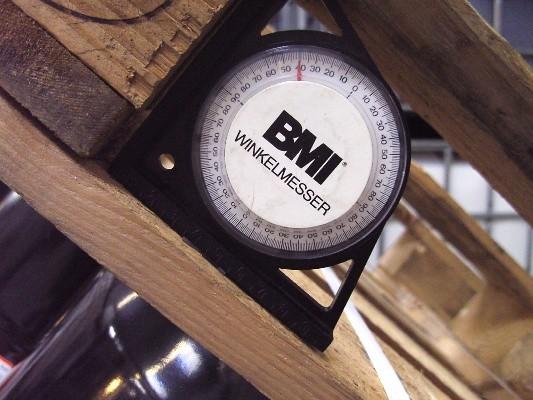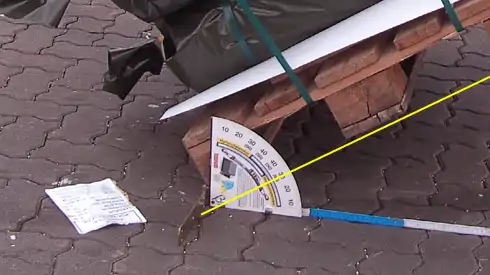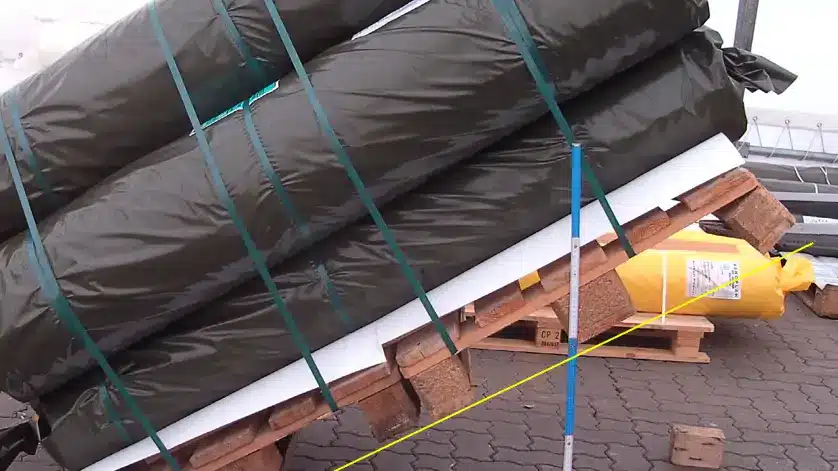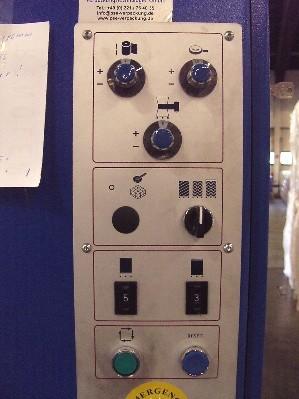
Now 10% off all Ergolash lashing straps save now! Voucher code: ergo10 | Valid until 31.05.2025
First of all, the destination to be reached should be determined. This depends on the means of transportation, as it makes a difference whether only truck transport or combined transport takes place. It may also be that only a new packaging variant is to be tested. The following list is indicative and not exhaustive.
It is important to determine which goal is to be achieved. For example: Improve the load unit so that a tilt angle of 26 degrees is achieved, because this corresponds to an acceleration of 0.5g. This result must be achieved three times in succession without the internal structure of the load unit disintegrating.
It makes sense to mark out an area in the storage area or another covered area that will not be used by others during the tests. If necessary, mark it with flutter tape.
It is advisable for the forklift operator to familiarize himself with the procedure and practice lifting the pallet a few times. The subsequent results will depend on whether the forklift operator works properly. It is important that he lifts the pallet with a smooth, slow movement to the desired angle and does not interrupt the movement. When interrupting and resuming the lifting process, acceleration peaks often occur, which distort the result. On the other hand, such peaks show how a loading unit reacts to vertical accelerations caused by bumps, kerbs, potholes or similar.
Several loading units should be available to save time for recovery in the event of unexpected behavior, e.g. overturning.
The tipping angles can be measured in different ways. Which one is used depends crucially on the type of load unit.
a.: Protractor on or at the loading unit.
If the load unit has a fixed frame or parts that do not deform relative to the load carrier, the protractor can be attached there. You also need to decide whether to use an electronic or manual system. There are cell phone apps that measure the angle very accurately. However, the way in which the cell phone is attached to the load unit for dynamic measurement is a problem. Mechanical protractors, which work on the principle of gravity, are less problematic.

It is important to check how the protractor can be secured. Stable load units are more suitable than those that can lose their shape when tipped, e.g. cardboard boxes, canisters, buckets, etc. In the example on the left, the protractor is attached to the top pallet of a pallet with drums.
b.: Protractors that are not connected to the loading unit.
A simple solution is to make a protractor from a cardboard disk or a transparent material. Starting at one edge, the graduation is transferred to the material with a felt-tip pen. The length of the lines should be at least 50 cm. With this method, care must be taken to ensure that the zero point of the protractor always coincides with the tilting edge when the loading unit is lifted in order to avoid incorrect results.

Here the angle has been enlarged onto a plexiglass pane. The black lines are only moderately recognizable. A different color, e.g. yellow, would show up better. The number of the test can also be seen on the picture. This should be present on every picture so that it can be better assigned during documentation.
c.: Use of meter sticks
The angle can also be measured and calculated using meter sticks. To do this, a meter stick is placed on the floor with the zero point at the tilting edge. Here, too, care must be taken to ensure that the zero point and the tipping edge always coincide. In the second step, the distance between the bottom edge of the load carrier and the floor is measured at the 1m mark. A distance of 50cm would correspond to an acceleration of 0.5g, for example. This corresponds to the following calculation: 50cm / 100cm = 0.5 = tangent

The picture on the left shows an example. The angle can be read off with sufficient accuracy. Powerpoint can also be used to create documentation in this way by inserting a line that shows the angle parallel to the pallet edge.

The picture on the left shows an example where the protractor and meter stick were used in combination.

The angle can be read from the magnification.
30°=tan 0.5773

The tipping height can be read off from the magnification. 57cm / 100cm = 0.57
It can be seen that both methods are sufficiently accurate.
During the test run, two video cameras were to film the action from two different angles. More images are always better than too few. Synchronize the time of the recording devices beforehand so that the images can be compared later. Install a camera so that the angle can be read.
Two main results must be achieved during the test run:
The documentation has an important function. It should describe all the boundary conditions for the tests. For example, a photo with the settings of the stretch wrapper for the current test can be inserted.

A photo of the stretch wrapper control panel saves detailed descriptions.
to 6. packaging aids
If goods are secured to a load carrier using strapping, this corresponds to the “tie-down lashing” securing method. This means that the effect depends largely on the frictional forces within the load unit and between the load carrier and the first layer. The frictional force is generated by the pre-tensioning force in the strapping. If this pre-tensioning force is lost, the securing force is no longer present and the load unit is no longer safe to transport. There are many reasons for this. For example, a cardboard box can tear, the strap can slip away from the drum circumference or the strapping gives way to the pre-tension (especially PP strap).
Wrap film/stretch film can be used to automatically secure a load unit, for example. However, care must be taken to ensure that a uniformly thick layer of film is achieved over the entire height of the load unit and that the load carrier is also integrated.
Edge protectors can be used in conjunction with strapping or wrapping film to form the load unit into a compact load. The angles can be attached both vertically and horizontally.
Edge protection corners prevent the strapping from pressing into the cardboard during tensioning and thus losing the pre-tensioning force. They can also be replaced by edge protectors.
As in all areas of load securing, anti-slip materials can also be used in a loading unit. An anti-slip layer pad in the format 120x80cm is well suited to stabilize the stacking of cartons.
There are of course many other materials that are suitable for securing load units. There are no limits to the imagination. The aim must always be to form a unit from the individual packages on a load carrier that behaves as one piece during transportation.
The following must be observed during tilting:
From these observations, conclusions can be drawn as to which measures are most likely to stabilize the loading unit.
This extensive topic can be further detailed, but would be too extensive at this point. My recommendation is to tackle the tests and learn from them. Don’t worry if the loading unit doesn’t behave as expected. Tackle it with courage and continue with improvements.
I wish you good courage and happy work.
Stay tuned.
Yours, Sigurd Ehringer
Previous article >>
Episode 55: Securing load units: the tipping test with the forklift truck
To the next post >>

Thomas Bauer
✔ Marketing | Web | CI
Rothschenk assortment
Our customer center has only one goal: to turn your problems into solutions. Whether standard stowage cushions, bestsellers or load securing personally tailored to your needs -. we accompany you consistently from A as in field service to Z as in certification. That is our promise to you, as a leader in our industry.
We attach great importance to professional cargo securing. That is why we have our own production, which ensures reliable operation through modern manufacturing technologies and strict quality control. Thus, we offer our customers a comprehensive and high-quality range of services in the field of transport logistics.
DIN ISO 9001:2015, EMAS and Ecovadis are not foreign words to you? Then it's time to work with the best.
You don't take any risks with us - we have been awarded the Platinum Medal on the EcoVadis sustainability rating platform.
As a load securement company, we are proud to have several certifications that validate our sustainability efforts and our commitment to environmental protection and social responsibility. For you as a purchaser, this means that we demand and promote the implementation of high environmental and social standards both within the company and along the supply chain.
G&H GmbH Rothschenk
Industriestrasse 5 & 7-10
97239 Aub
Phone: +49 9335 97 15 – 79
Fax: +49 9335 97 15 – 15
E-mail: info@rothschenk.de
Collection/delivery
Mon – Fri: 8:00 – 15:00
Office hours
Mon – Thu: 8:00 – 17:00
Fri: 8:00 – 13:00
G&H GmbH Rothschenk
Industriestrasse 5 & 7-10
97239 Aub
Phone: +49 9335 97 15 – 0
Fax: +49 9335 97 15 – 15
E-mail: info@rothschenk.de
Collection/delivery
Mon – Fri: 8:00 – 15:00
Office hours
Mon – Thu: 8:00 – 17:00
Fri: 8:00 – 13:00
You are currently viewing a placeholder content from Google Maps. To access the actual content, click the button below. Please note that doing so will share data with third-party providers.
More Information